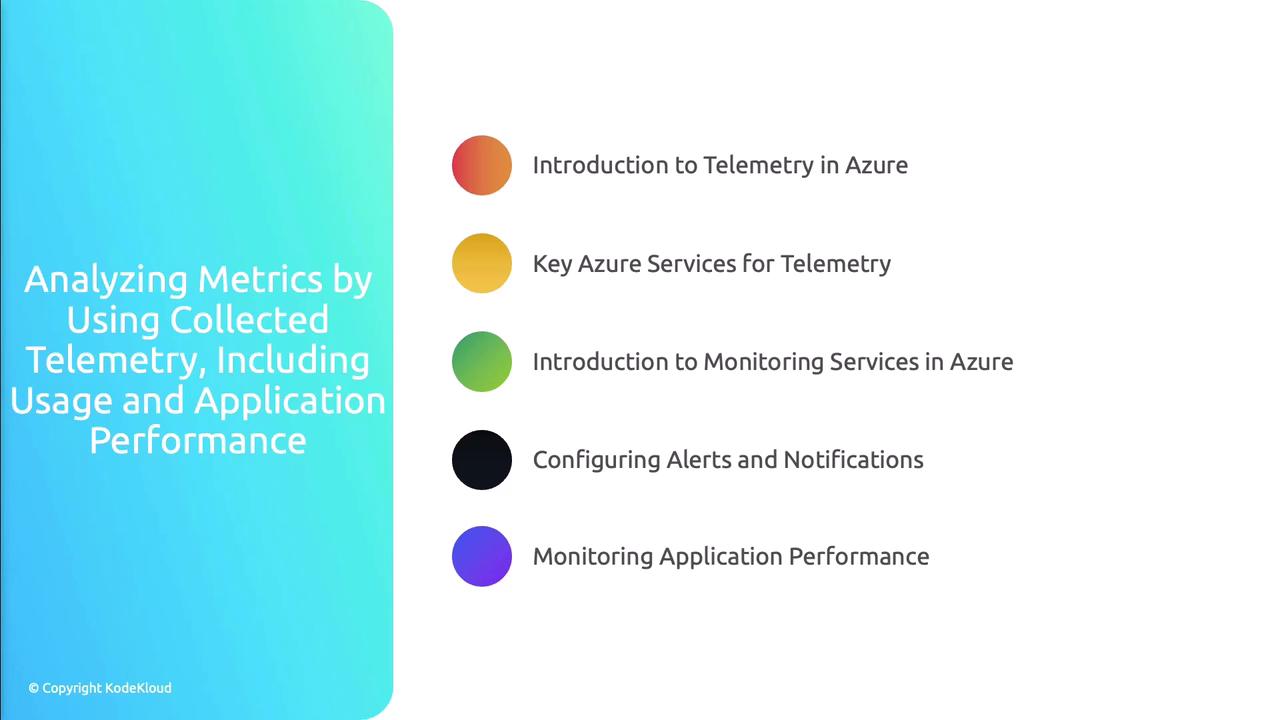AZ-400: Designing and Implementing Microsoft DevOps Solutions
Analyze Metrics
Summary Analyzing Metrics
In this lesson, we explore essential performance metrics and monitoring tools in Azure. Mastering these concepts is critical for the AZ-400 certification and for building robust, scalable cloud architectures. You’ll learn how to collect telemetry data, configure alerts, and create custom dashboards to streamline DevOps workflows.
Key Performance Metrics
| Metric Category | Metrics | Why It Matters |
|---|---|---|
| CPU Performance | CPU usage, CPU load | Identifies processing bottlenecks and scaling needs. |
| Memory Utilization | RAM consumption, memory pressure | Ensures application responsiveness and stability. |
| Disk Performance | IOPS, throughput, latency | Measures storage efficiency and data access speed. |
Note
Monitoring CPU, memory, and disk metrics proactively helps prevent performance degradation and service outages.
Azure Monitoring Tools
| Tool | Description | Reference |
|---|---|---|
| Azure Monitor | Centralized platform to collect and analyze telemetry. | Azure Monitor docs |
| Application Insights | Real-time application performance tracking and diagnostics. | Application Insights docs |
| Log Analytics | Powerful log aggregation and query engine. | Log Analytics docs |
Collecting and Analyzing Telemetry

Below are the key steps for leveraging telemetry in Azure:
Introduction to Telemetry in Azure
Collect performance and usage data from applications and infrastructure using Azure Monitor agents and SDKs.Analyzing Usage Metrics
Use built-in reports and queries in Log Analytics to understand service consumption patterns and optimize resource allocation.Monitoring Application Performance
Integrate Application Insights SDK into your codebase for end-to-end transaction tracking and real-time root-cause analysis.Configuring Alerts and Notifications
Define alert rules in Azure Monitor based on metric thresholds or log query results to receive proactive notifications.Creating Custom Dashboards
Build interactive dashboards in the Azure portal to visualize the most critical metrics, charts, and logs in one place.
Best Practices for Azure Telemetry
- Define clear, actionable alert thresholds to minimize false positives.
- Encrypt telemetry data both in transit and at rest to ensure compliance.
- Automate the provisioning of monitoring resources using Infrastructure as Code (IaC).
- Regularly review and refine dashboards and alert rules as application workloads evolve.
Warning
Over-alerting can lead to alert fatigue. Ensure each notification delivers actionable insights.
Links and References
Watch Video
Watch video content